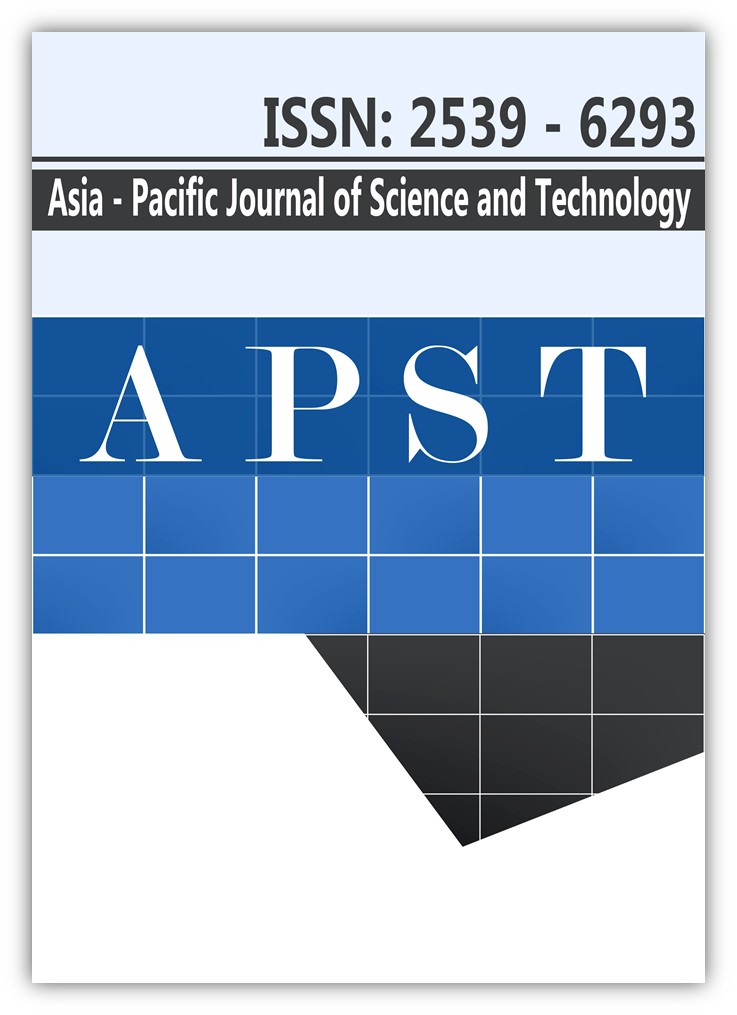Amphawan Maitarad
Materials Chemistry Research Center, Department of Chemistry and Center for Innovation in Chemistry, Faculty of Science, Khon Kaen University, Khon Kaen, Thailand
Nattawee Poomsuk
Materials Chemistry Research Center, Department of Chemistry and Center for Innovation in Chemistry, Faculty of Science, Khon Kaen University, Khon Kaen, Thailand
Chittima Laohpongspaisan
Materials Chemistry Research Center, Department of Chemistry and Center for Innovation in Chemistry, Faculty of Science, Khon Kaen University, Khon Kaen, Thailand
Khatcharin Siriwong
Materials Chemistry Research Center, Department of Chemistry and Center for Innovation in Chemistry, Faculty of Science, Khon Kaen University, Khon Kaen, Thailand
DOI: https://doi.org/10.14456/kkurj.2018.10
Keywords: Peptide nucleic acid Molecular dynamics simulation Quantum calculation
Abstract
The binding ability of pyrrolidinyl peptide nucleic acid (PNA) binding to its complementary DNA and self-paring has been studied experimentally. However, a detailed understanding of the binding property is still unclear due to the lack of their crystallographic data. In this work, structural and energetic properties of PNA-DNA and PNA-PNA duplexes were studied using molecular dynamics (MD) simulations and quantum calculations. The studied pyrrolidinyl PNA backbone was (2¢R,4¢R)-prolyl-(1S,2S)-2-aminocyclobutanecarboxylic acid. MD simulations of three different forms (A–, B– and P–form) were performed in order to investigate the probable duplex conformation. As the results, PNA-PNA duplex exhibited the structural feature between A- and P-type conformations, while PNA-DNA double helix clearly showed the characteristic of B-form. In addition, quantum calculations revealed that the interaction of PNA-DNA duplex was larger than that of PNA-PNA duplex, indicating higher intrinsic stability of PNA-DNA compared to PNA-PNA double strand. This research may lead to a design of PNA for further applications.
How to Cite
Maitarad, A., Poomsuk, N., Laohpongspaisan, C., & Siriwong, K. (2018). Theoretical study of peptide nucleic acid with(2’R,4’R)-prolyl-(1S,2S)-2-aminocyclobutanecarboxylic acid acid backbone binding to DNA and self-pairing. Asia-Pacific Journal of Science and Technology, 23(2), APST–23. https://doi.org/10.14456/kkurj.2018.10
References
Blackburn GM, Gait MJ, Loakes D, Williams DM. Nucleic acids in chemistry and biology. 3rd ed. Cambridge: RSC Publishing; 2006.
Dahm R. Friedrich Miescher and the discovery of DNA. Dev Biol. 2005;278:274–288.
Dahm R. Discovering DNA: Friedrich Miescher and the early years of nucleic acid research. Hum Genet. 2008;122:565–581.
Nielsen PE, Egholm M, Berg RH, Buchardt O. Sequence-selective recognition of DNA by strand displacement with a thymine-substituted polyamide. Science 1991;254:1497–1500.
Egholm M, Buchardt O, Nielsen PE, Berg RH. Peptide nucleic acids (PNA). Oligonucleotide analogs with an achiral peptide backbone. J Am Chem Soc. 1992;114:1895–1897.
Hyrup B, Nielsen PE. Peptide nucleic acids (PNA): synthesis, properties and potential applications. Bioorg Med Chem. 1996;4:5–23.
Ray A, Nordén B. Peptide nucleic acid (PNA): its medical and biotechnical applications and promise for the future. FASEB J. 2000;14:1041–1060.
Porcheddu A, Giacomelli G. Peptide nucleic acids (PNAs), a chemical overview. Curr Med Chem. 2005;12:2561–2599.
Gambari R. Peptide nucleic acids: a review on recent patents and technology transfer. Expert Opin Ther Pat. 2014;24:267–294.
Vilaivan T, Suparpprom C, Harnyuttanakorn P, Lowe G. Synthesis and properties of novel pyrrolidinyl PNA carrying β-amino acid spacers. Tetrahedron Lett. 2001;42:5533–5536.
Vilaivan T, Srisuwannaket C. Hybridization of pyrrolidinyl peptide nucleic acids and DNA: selectivity, base-pairing specificity, and direction of binding. Org Lett. 2006;8:1897–1900.
Taechalertpaisarn J, Sriwarom P, Boonlua C, Yotapan N, Vilaivan C, Vilaivan T. DNA-, RNA- and self-pairing properties of a pyrrolidinyl peptide nucleic acid with a (2’R,4’S)-prolyl-(1S,2S)-2-aminocyclopentanecarboxylic acid backbone. Tetrahedron Lett. 2010;51:5822–5826.
Vilaivan C, Srisuwannaket C, Ananthanawat C, Suparpprom C, Kawakami J, Yamaguchi Y, Vilaivan T. Pyrrolidinyl peptide nucleic acid with α/β-peptide backbone: a conformationally constrained PNA with unusual hybridization properties. Artif DNA PNA XNA 2011;2:50–59.
Mansawat W, Vilaivan C, Balázs Á, Aitken DJ, Vilaivan T. Pyrrolidinyl peptide nucleic acid homologues: effect of ring size on hybridization properties. Org Lett. 2012;14:1440–1443.
Vilaivan T. Pyrrolidinyl PNA with alpha/beta-dipeptide backbone: from development to applications. Acc Chem Res. 2015;48:1645–1656.
Siriwong K, Chuichay P, Saen-oon S, Suparpprom C, Vilaivan T, Hannongbua S. Insight into why pyrrolidinyl peptide nucleic acid binding to DNA is more stable than the DNA·DNA duplex. Biochem Biophys Res Commun. 2008;372:765–771.
Poomsuk N, Siriwong K. Structural properties and stability of PNA with (2’R,4’R)- and (2’R,4’S)-prolyl-(1S,2S)-2-aminocyclopentanecarboxylic acid backbone binding to DNA: a molecular dynamics simulation study. Chem Phys Lett. 2013;588:237–241.
Rasmussen H, Kastrup JS, Nielsen JN, Nielsen JM, Nielsen PE. Crystal structure of a peptide nucleic acid (PNA) duplex at 1.7 Å resolution. Nat Struct Mol Biol. 1997;4:98–101.
Lu XJ, Olson WK. 3DNA: a software package for the analysis, rebuilding and visualization of three-dimensional nucleic acid structures. Nucleic Acids Res. 2003;31:5108–5121.
Case DA, Darden TA, Cheatham TE, Simmerling CL, Wang J, Duke RE, et al. AMBER 12. University of California: San Francisco; 2012.
Jorgensen W. Transferable intermolecular potential functions for water, alcohols, and ethers. Application to liquid water. J Am Chem Soc. 1981;103:335–340.
Ryckaert JP, Ciccotti G, Berendsen HJC. Numerical integration of the cartesian equations of motion of a system with constraints: molecular dynamics of n-alkanes. J Comput Phys. 1977;23:327–341.
Darden T, York D, Pedersen L. Particle mesh Ewald: an N⋅log(N) method for Ewald sums in large systems. J Chem Phys. 1993;98:10089–10092.
Frisch MJ, Trucks GW, Schlegel HB, Scuseria GE, Cheeseman JR, Scalmani G, et al. Gaussian 09 Revision B.01. Wallingford CT: Gaussian; 2009.
Pettersen EF, Goddard TD, Huang CC, Couch GS, Greenblatt, DM, Meng EC, Ferrin TE. UCSF chimera-a visualization system for exploratory research and analysis. J Comput Chem. 2004;25:1605–12.
Saenger W. Principles of nucleic acid structure. New York: Springer-Verlag; 1984.

Published:
License
This work is licensed under a Creative Commons Attribution-NonCommercial-NoDerivatives 4.0 International License.
